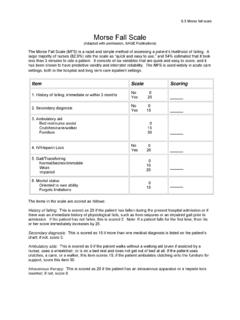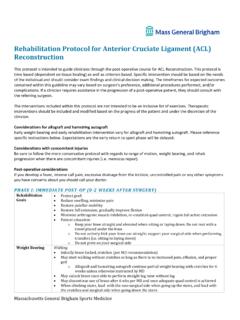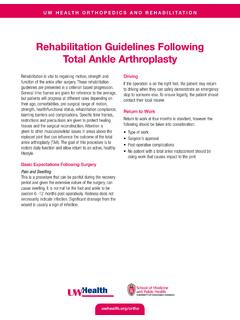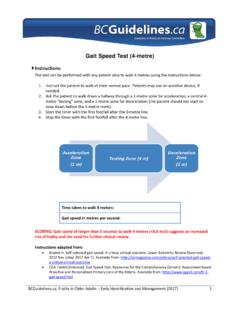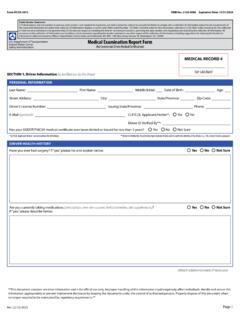Transcription of DYNAMIC GAIT INDEX - CPT Rehab
1 DYNAMIC gait INDEX The DYNAMIC gait INDEX was developed by Anne Shumway-Cook (1995) and has been used with older adults to determine their likelihood of falling. Scores of 19 and less are related to falls in older adults. It tests 8 facets of gait and can be be used with an assistive device. Patient Name: _____ Rater: _____ A. gait level surface B. Change in gait speed C. gait with horizontal head turns D. gait with vertical head turns E. gait and pivot turn F. Step over obstacle G. Step around obstacle H. Stairs TOTAL SCORE59-4014 12/11 Date Date Date DatePatient Name: _____ Signature: _____ Date: _____A. gait Level Surface Instructions: Walk at your normal speed from her to the next mark (20 feet). Check th lowest category that applies. 0. Severe Impairment: Cannot walk 20 ft. without assistance, severe gait deviations, or imbalance. 1. Moderate Impairment: Walks 20 feet, slow speed, abnormal gait pattern, evidence for imbalance. 2. Mild Impairment: Walks 20 feet, uses assistive devices, slower speed, mild gait deviations.
2 3. normal : Walks 20 feet, no assistive devices, good speed, no evidence of imbalance, normal gait Change in gait Speed Instructions: Begin walking at your normal pace (for 5 ft.). When I tell you GO , walk as fast as you can (for 5 ft.). When I tell you SLOW , walk as slowly as you can (for 5 ft.). Check the lowest category that applies. 0. Severe Impairment: Cannot change speeds, or loses balance and has to reach for wall or be caught. 1. Moderate Impairment: Makes only minor adjustments to walking speed or accomplishes a change in speed with significant gait deviations, or changes speed but has significant gait deviations, or changes speed but loses balance but is able to recover and continue walking. 2. Mild Impairment: Able to change speed but demonstrates mild gait deviations, or no gait deviations but unable to achieve a significant change in velocity, or uses an assitive device. 3. normal : Able to smoothly change walking speed without loss of balance or gait deviation.
3 Shows significant difference in walking speeds between normal , fast, and slow gait with Horizontal Head Turns Instructions: Begin walking at your normal pace. When I tell you look right , keep walking straight, but turn your head to the right. Keep looking to the right until I tell you look left , then keep walking straight and turn your head to the left. Keep your head to the left until I tell you look straight . then keep walking straight but return your head to the center. Check the lowest category that applies. 0. Severe Impairment: Performs task with severe disruptions of gait ( - staggers outside 15 inch path, loses balance, stops, reaches for wall). 1. Moderate Impairment: Performs head turns with moderate change in gait velocity, slows down, staggers but revovers, can continue to walk. 2. Mild Impairment: Performs head turn somoothly with slight change in gait velocity ( - minor disruption to smooth gait path or uses walking aid). 3. normal : Performs head turns smoothly with no change in gait with Vertical Head Turns Instructions: Begin walking at your normal pace.
4 When I tell you look up , keep walking straight, but tip your head and look up. Keep looking up untill I tell you look down , then keep walking straight and turn your head down. Kepp your head down until I tell you look staright , then keep walking straight but return your head to the center. Check the lowest category that applies. 0. Severe Impairment: Performs task with severe disruptions of gait ( - staggers outside 15 inch path, loses balance, stops, reaches for wall. 1. Moderate Impairment: Performs task with moderate change in gait velocity, slows down, staggers but recovers, can continue to walk. 2. Mild Impairment: Performs task with slight change in gait velocity ( - minor diruption to smooth gait path or uses walking aid). 3. normal : Performs head turns with no change in gait and Pivot Turn Instructions: Begin walking at your normal pace. When I tell you stop and turn , turn as quickly as you can to face the opposite direction and stop. Check the lowest category that applies.)
5 0. Severe Impairment: Cannot turn safely, requires assistance to turn and stop. 1. Moderate Impairment: Turns slowly, requires verbal cueing, requires several small steps to catch balance following turn. 2. Mild Impairment: Pivot turns safely in greater than 3 seconds and stops with no loss of balance. 3. normal : Pivots and turns safely within 3 seconds and stops quickly with no loss of Step over Obstacle Instructions: Begin walking at your normal speed. When you come to the shoebox, step over it, not around it, and keep walking. Check the lowest category that applies. 0. Severe Impairment: Cannot perform activity without assistance. 1. Moderate Impairment: Able to step over box, but must stop, then step over. May require verbal cueing. 2. Mild Impairment: Able to step over box, but must slow down and adjust steps to clear box safely. 3. normal : Able to step over box without changing gait speed; no evidence of Step around Obstacles Instructions: Begin walking at you normal speed.
6 When you come to the first cone (about 6 ft. away), walk around the right side of it. When you come to the second cone (about 6 ft. past first cone), walk around it to the left. Check the lowest category that applies. 0. Severe Impairment: Unable to clear cones, walks into one or both cones, or reqires physical assistance. 1. Moderate Impairment: Able to clear cones but must significantly slow speed to accomplish task, or requires verbal cueing 2. Mild Impairment: Able to step around both cones, but must slow down and adjust steps to clear cones. 3. normal : Able to walk around cones safely without changing gait speed; no evidence of Stairs Instructions: Walk up these stairs as you would at home ( - using the rail if necessary) At the top, turn around and walk down. Check the lowest category that applies. 0. Severe Impairment: Cannot perform safely. 1. Moderate Impairment: Two feet to a stair, must use rail. 2. Mild Impairment: Alternating feet, must use rail.
7 3. normal : Alternating feet, no rail.


